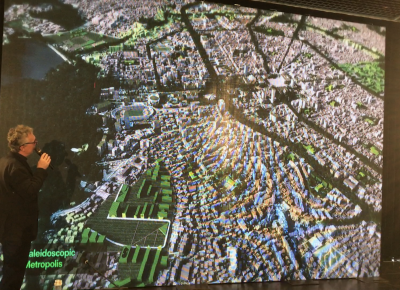Italians design Tirana again, a century later

MILAN -- Tirana City Council approved a General Local Plan designed by the Italian architectural firm Stefano Boeri Architetti (SBA), together with UNLAB and IND offices, to regenerate the Albanian capital, SBA said Wednesday.
In 2015, the Italian-Dutch team won an international competition set by the Albanian Government, after an administrative reform that drastically reduced the amount of Municipalities in the whole territory.
The General Local Plan called “Tirana 2030” (Tr030), designed by the architect Stefano Boeri together with UNLAB and IND (winners of an international competition at the beginning of 2016), was approved just last week. It is an ambitious and major project that, 100 years on from a previous General Local Plan designed by Italian architects (led by Armando Brasini), marks a new stage in the future of the Albanian capital.
The new General Local Plan, strongly desired by Edi Rama’s government (the previous Mayor of Tirana) and by the current Mayor Erion Veliaj’s administration, includes the entire metropolitan area of Tirana and also takes into consideration rail links with the airport and the port of Durazzo, green areas and green corridors, public transportation, new areas of controlled development and the enhancement of the architectural heritage of the city.
Stefano Boeri’s General Local Plan avoids the city growing beyond its current boundaries, thanks to planting an “orbital forest” of 3 million new trees. Tirana will grow along its historical paths ((Boulevard Dëshmorët e Kombit, the second and the fourth ring, Tirana-Durazzo axis and the 5 development areas) without natural or agricultural soil consumption, but rather multiplying green areas, facilities and public spaces.
Thanks to the creation of two green rings inside the central area, suitable for cycling and walking, of a big natural oasis around the lake Farka and of new green strips along rivers, green surfaces in the city will triple.
The creation of 20 new public schools, together with the new World Square, will allow the development of a web of new urban squares featuring cultural activities and facilities.
Boeri’s project also redefines urban mobility -- introducing a congestion charge in central areas, promoting car sharing, favoring a system of “bus only lines” -- and extra-urban mobility with fast connections between the Boulevard and the airport, promoting an improvement of links with peripheral towns.
The General Local Plan redefines, both inside the historic city and in the suburban and rural areas, new cores of urban, economic and social development of the new Tirana polycentric metropolis.
A green corridor, where energy production will be incentivized through the application of renewable resources, will contribute to feed the city and its growth.
In relation to the current plan, the recently approved general local plan has reduced by two thirds the previsions of demographic development in the metropolitan area and has reshaped a green metropolis, accessible to everyone -- a kaleidoscopic metropolis that will encourage plurality of the established functions and the mix of activities.
Before coming into action, the new General Local Plan TR 030, will have to be approved by the National Council at the end of January 2017.
nkd


